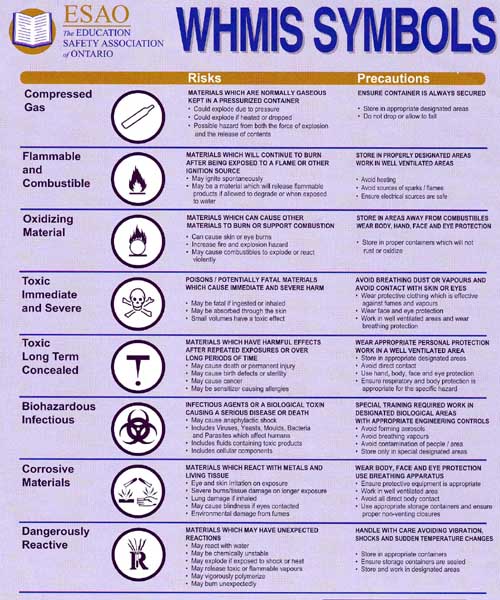
Tuesday's Assignment
Good morning everyone,
I hope that everyone has enjoyed our long,
nice weekend (Victoria's Day).
This week's theme is on the health and safety measures at the
workplace. One of the most important things we should know of is called: WHMIS
It is a Canada-wide system to provide information
on hazardous materials used in the workplace. WHMIS was developed by the collaborative
efforts of government, industry and labour and is supported by both federal and
provincial legislation.
Exposure to
hazardous materials can cause or contribute to a variety of health effects such
as irritation, burns, sensitization, heart aliments, kidney and lung damage and
cancer. Some materials may also contribute to fires, explosions and other
accidents if improperly stored or handled. It is estimated that about 25% of
Canadian workers are exposed to chemical hazards on the job.
Task 1:
What does WHMIS stand for?
Task 2:
Click on this link, read the instruction and then type your answers on a Word document.
What's the difference between hazards at work and in everyday life?Task 2:
Click on this link, read the instruction and then type your answers on a Word document.
- Find a synonym for Hazard?
- What's the difference between hazards at work and in everyday life?
- How can I recognize hazards at work?
- What should I do if I recognize hazards at work?
Task 3:
Briefly explain, in your words, the four main types of hazards and give few examples on each.
between hazards at work and in everyday life?
What's the difference between hazards at work and in everyday life?
WHMIS stands for what is hazardous material immediate and severe.
ReplyDeleteWHMIS (Workplace Hazardous Materials Information System)
ReplyDeleteWHMIS: Workplace Hazardous Materials Information System
ReplyDeleteWHMIS stand for hazard happened in our daily life and workplace.
ReplyDeleteA synonym for Hazard is injury.
The difference between hazards at work and in everyday life is you've learned from an early age how to deal with everyday hazards but you haven't been trained how to recognize, assess and control hazards found in the workplace.
We have physical hazards, biological hazards, ergonomic hazards and chemical hazards at work.
Some hazards require immediate attention which can be quickly fixed .Some hazards that can hurt you in the long term also need to be identified and reported promptly.
Task 1
ReplyDeleteWHMIS :stands for Workplace Hazardous Materials Information System
Task 2
1. Hazard: endanger
2. the difference between hazards at work and in everyday life is that in our every day life , usually, you can recognize it by your own knowledge, because that is common sense for us. But if you at work, you need to be trained to recognize hazards.
3. I can recognize hazards by the symbols and labels which on the equipment or containers at workplace, also, I can recognize hazards by traning.
4. If I recognize hazards at work, I need to follow the instruction which is on the equipment or containers, ensure to protect myself properly. If there something unknown by my knowledge, I will ask my colleague or supervisor for help.
WHMIS stand for:Workplace hazardous materials information system.
ReplyDeleteTask 2
ReplyDelete1-Hazard: Danger or generally anything can hurt you or make you sick.
2- The different between hazard at work and in every life is you deal with hazards in your life with
you've learned from your own experiences but you haven't been trained how to recognize, assess and control hazards found in the workplace.
3-We can be recognize hazards in the work by assigned four main types of hazards: Physical hazards, Biological hazards, Ergonomic hazards, and chemical hazards.
3-First one assessing its potential to cause injury and the extent of the hazard is a necessary step in determining how the hazard can be addressed.
A synonym for Hazard is danger.
ReplyDeleteI found there are four kinds of hazard in work from the website mentioned, physical hazards, ergonomic hazards, chemical hazards, and biological hazards. For example, the first picture might be happened in a kitchen. Repeating the same movements over and over will result in ergonomic hazard. That is say, to keep cutting and frying potato will cause long-term injuries. Another example is in the second picture that is happened in a grocery store. Carrying some bags on his shoulders is to result in physical hazards.The third picture is happened in a office. To keep typing and working in front of the computer will result in ergonomic hazard.
If I recognize the hazard at work, I will protect myself to avoid to be hurt in case. On the meantime, I would like to find more health and suitable job for myself.